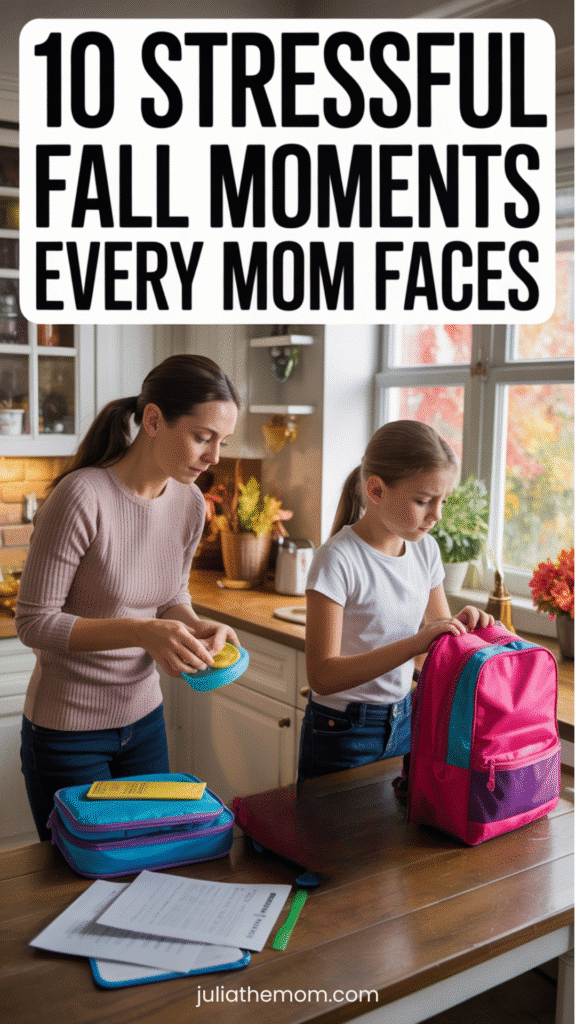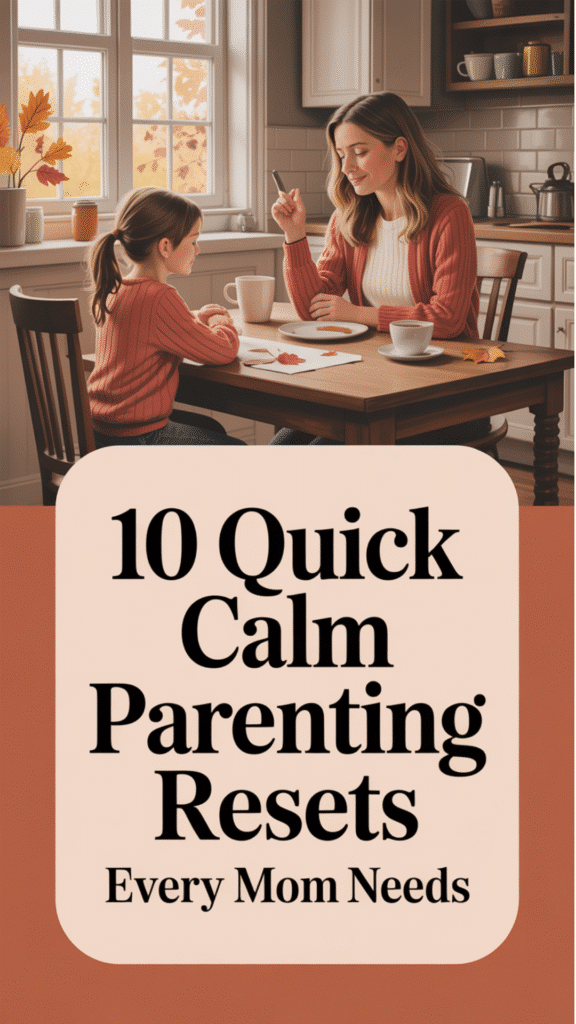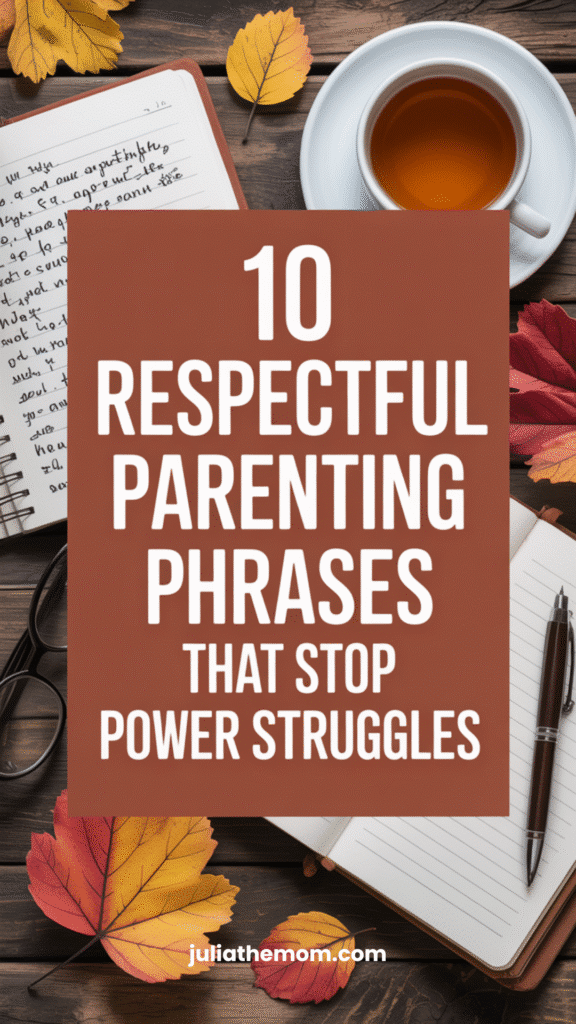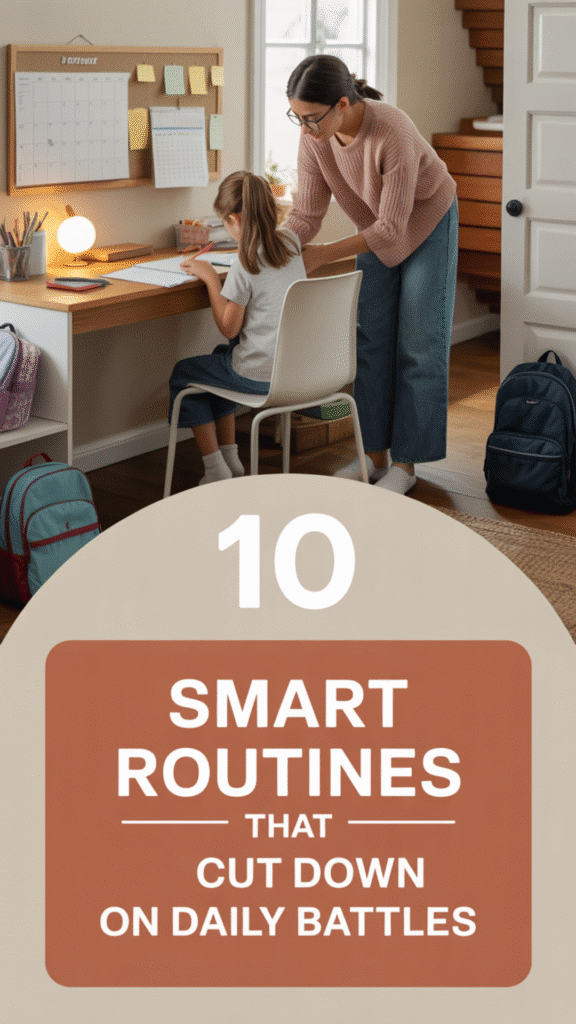Fall rush hits hard: school mornings, after-school chaos, work deadlines, and kids who suddenly push back on everything. It’s exhausting — and yelling feels like the quickest way to get things done. But here’s the truth: parenting without yelling is possible, even in the busiest season.
It’s not about being a perfect mom or having endless patience — it’s about having quick resets, smart phrases, and simple routines that keep you calm when your kids test limits. These 33 hacks will help you master parenting without yelling while actually keeping your sanity intact.
Table of Contents
Why Fall Feels So Overwhelming for Moms and Kids

Fall doesn’t ease in gently — it hits like a freight train. One minute it’s late summer and you’re still letting the kids stay up late, the next minute it’s alarms at 6:30, packed lunches, and a calendar full of “mandatory” events. Here’s why it feels like too much (because it is):
- Back-to-school mornings = pure chaos. Somebody can’t find their sneakers, the printer jams when you’re trying to spit out that one permission slip, and of course someone suddenly remembers “I need poster board TODAY.” It’s all before coffee has kicked in.
- Homework battles after a full day. Your kid swears they “don’t have homework,” then melts down when you remind them that math worksheet does count. Meanwhile you’re trying not to lose it because you’re mentally still in work mode.
- After-school activity overload. Soccer practice, piano lessons, Girl Scouts — and that’s just Tuesday. You’re basically running a family Uber service, except with complaints about snacks.
- Work deadlines don’t stop. For moms working from home, the interruptions are brutal: one earbud in a Zoom meeting while your child waves a crumpled permission slip in your face.
- Shorter daylight = less energy. By 5 p.m., it’s pitch black outside. The kids are cranky, you’re cranky, and dinner feels like an Olympic event you never signed up for.
- Seasonal transitions mess with everyone. New teachers, new routines, new expectations. Kids push back because they’re adjusting — and you push back because, honestly, you are too.
- Paperwork avalanche. The endless school emails, signup forms, “spirit week” reminders, and fundraisers. You need a project manager just to keep up.
- Meals squeezed into tight schedules. Cooking while helping with spelling words, answering Slack messages, and refereeing sibling fights. It’s not family dinner, it’s multitasking triage.
- Holiday prep sneaks in early. Suddenly you’re buying Halloween costumes, planning Thanksgiving, and hiding Christmas gifts in the back of your closet. You’re already tired, and it’s only October.
- Everyone’s just… worn out. When kids are exhausted, they dig in their heels. When moms are exhausted, we lose patience. That’s when yelling feels easier than connection.
👉 And that’s the real trap of the fall rush: it drains everyone at once. But here’s the good news — smart parenting gives you tools to slow the spiral, reset your own stress, and keep the bond strong with your kids (even when they’re eye-rolling or slamming doors).
10 Quick Calm Parenting Resets Every Mom Needs (Parenting Without Yelling Made Easier)

Let’s be honest: sometimes parenting without yelling feels impossible — especially in the middle of school chaos, after-work fatigue, and endless kid pushback. But here’s the truth: you don’t need an hour of meditation or a perfect morning routine to reset. These 10 quick calm parenting resets every mom needs are fast, practical, and realistic enough to use when life is messy and loud.
- Pause + breathe (even in the pantry)
- How: Step away, close a door if you can. Inhale 4, exhale 6 — do 3–5 rounds. Put one hand on your belly so you feel it rise.
- Say (to yourself): “Long exhale, slow down.”
- Use when: Voices are rising; you feel heat in your chest.
- Pro tip: Stare at one fixed point while you breathe — it quiets your nervous system faster.
- Take a 60-second timeout (for you)
- How: State it plainly: “I need one minute to calm down.” Step into the hallway/bathroom. Set a 60-sec timer. Breathe, shake out your hands, roll your shoulders.
- Say (to your child): “I’ll be right back, then we’ll figure this out.”
- Use when: You’re about to snap.
- Pro tip: Pre-teach this family rule on a calm day so kids aren’t alarmed when you step away.
- Hand-on-heart grounding
- How: Palm on chest, slight pressure. Inhale once, then name 3 things you see, 2 you hear, 1 you feel (the floor, your sweater).
- Say: “I’m safe. I can handle this conversation.”
- Use when: You feel buzzy or shaky.
- Pro tip: Invite co-regulation: “Put your hand here with me; let’s take one slow breath together.”
- Name your feeling out loud
- How: Use an “I” statement + one word: “I’m frustrated.” (Not: “You’re making me…”)
- Say (script): “I’m frustrated and I need a second to think.”
- Use when: You want to model self-control without suppressing emotions.
- Pro tip: Add a quick scale: “I’m at a 7/10. I’m going to get to a 4 and then we’ll talk.”
- Water reset
- How: Take 6 slow sips of water. While sipping, do 1 deep inhale + long sigh out through the mouth.
- Say: Nothing — the pause is the point.
- Use when: Your mouth is dry, thoughts are racing.
- Pro tip: Rinse wrists under cool water for 10 seconds — fast track to calm.
- Count backwards (whisper)
- How: Whisper 10→1 at a steady beat (about 1 sec each). Tap a finger for each number to add rhythm.
- Say: “I’m going to count down and then we’ll choose our next step.”
- Use when: You need a micro-buffer before you answer or set a limit.
- Pro tip: Pair with one slow exhale on 5 and another on 1.
- Micro-rehearsal: visualize the next right step
- How: Close your eyes for 5 seconds. Picture the very next calm move (e.g., “I say, ‘Snack first, then homework.’”).
- Say (to yourself): “Next right step, not the whole night.”
- Use when: You’re spiraling into “this always/never” thinking.
- Pro tip: Add an if-then: “If they argue, then I repeat once and start the timer.”
- Lower, slower, fewer words
- How: Drop your voice half a level, slow your pace, trim your sentence to 8–10 words. Kneel to eye level if possible.
- Say (script): “I hear you. Snack first, homework next. Let’s start.”
- Use when: Kid is escalating; long lectures will backfire.
- Pro tip: Relax your jaw and shoulders before you speak — kids read your face.
- Sensory anchor (tiny ritual = big reset)
- How: Choose one: light a candle, roll lavender on wrist, hold a cool stone, sip warm tea. Stay with the sensation for 10 slow seconds.
- Say: “Pause. Smell. Exhale.”
- Use when: You need a body-level interrupt, not more thinking.
- Pro tip: Keep a mini “calm kit” where meltdowns happen (kitchen/entryway): tea bag, roller, smooth pebble.
- Permission to walk away — and return
- How: State boundary + plan: “I’m taking two minutes to calm down. I’ll be back and we’ll decide about screens.” Step away, regulate (breath, water, stretch), then return and follow through.
- Say (on return): “Thanks for waiting. Here’s the plan: snack, then homework.”
- Use when: You’re at a 9/10 and connection isn’t possible yet.
- Pro tip: Safety first — only step away if your child is safe; otherwise use a whisper + hand-on-heart grounding on the spot.
10 Respectful Parenting Phrases That Stop Power Struggles

When kids dig their heels in, it’s so tempting to raise your voice or throw out a quick threat. But parenting without yelling works best when you’ve got simple scripts ready to go. These 10 respectful parenting phrases stop power struggles in their tracks — they’re short, calm, and surprisingly effective at keeping connection front and center.
- Validation first
- Say this: “I can see this is hard for you.”
- Not that: “Stop whining, it’s not a big deal.”
- Why it works: When kids hear their feelings named, their brain shifts out of fight mode. Instead of escalating to “prove” they’re upset, they feel understood — and that lowers the pushback.
- Choices over commands
- Say this: “Do you want to start homework now or after a 10-minute break?”
- Not that: “Do your homework right now!”
- Why it works: Offering two choices gives your child a sense of control in a moment they feel powerless. Resistance drops when they feel like they had a say.
- Empathy mirror
- Say this: “I get it — I don’t always feel like doing things either.”
- Not that: “Life isn’t fair, get used to it.”
- Why it works: Empathy takes the edge off defensiveness. Kids soften when they realize you understand how they feel.
- Problem-solver shift
- Say this: “What’s one thing that would make this easier?”
- Not that: “You’re just being lazy.”
- Why it works: Instead of shaming, you invite them to brainstorm. That shift flips the situation from resistance to collaboration.
- Teamwork framing
- Say this: “I hear you. Let’s figure it out together.”
- Not that: “Because I said so, that’s why.”
- Why it works: Moves the energy from power struggle to partnership. Kids cooperate more when they feel you’re on their team.
- Small choice, clear rule
- Say this: “Homework first, then free time. Which subject do you want to start with?”
- Not that: “You can’t watch TV until you finish everything.”
- Why it works: The rule stays firm, but small choices inside the boundary lower resistance. Kids accept structure more when they have input.
- Confidence boost
- Say this: “I trust you to handle this.”
- Not that: “If I don’t stand over you, you’ll never finish.”
- Why it works: Kids often rise to the level of trust you show them. Belief in their ability encourages them to step up.
- Reframe the fight
- Say this: “I’m not against you, I’m on your side.”
- Not that: “Why are you always fighting me on this?”
- Why it works: Changes the dynamic from “me vs. you” to “us vs. the problem.” Kids calm down faster when you’re an ally, not the enemy.
- Fresh start option
- Say this: “Let’s try again.”
- Not that: “You always mess this up.”
- Why it works: Offers a reset instead of shame. Kids learn they can repair and restart, not stay stuck in failure mode.
- Unshakable connection
- Say this: “I love you, even when we disagree.”
- Not that: “You’re driving me crazy.”
- Why it works: Reminds kids that conflict doesn’t threaten love. Feeling secure helps them calm faster and bounce back.
10 Smart Routines That Cut Down on Daily Battles

Calm phrases are powerful in the moment, but the real secret to parenting without yelling is building routines that cut drama before it starts. When kids know what to expect, they resist less, and when you’re not scrambling, you’ve got more patience to spare. These 10 smart routines take the edge off daily chaos so your home feels less like a battlefield and more like a team effort.
- Prep the night before
- How: Lay out clothes, pack backpacks, sign forms while the house is calm.
- Why it works: Mornings become smoother when there are fewer last-minute scrambles. Kids know what’s ready, you’re not rushing, and everyone leaves the house less stressed.
- Visible family calendar
- How: Hang a wall calendar or whiteboard where everyone can see it.
- Why it works: Kids push back less when they know what’s coming (practice, projects, parties). Surprises trigger resistance — clarity calms.
- Snack station ready to grab
- How: Keep healthy snacks prepped in clear containers.
- Why it works: A quick refuel after school prevents meltdowns. Balanced blood sugar = fewer fights over homework or chores.
- Built-in downtime
- How: Plan 10–15 minutes of “nothing” after school before diving into homework.
- Why it works: Kids need decompression just like adults after work. Giving them a reset lowers pushback later.
- Homework station setup
- How: Create a small, consistent spot with pencils, paper, chargers ready.
- Why it works: No more “I can’t find a pencil!” excuses. A set space signals “this is homework mode” and reduces stalling.
- Consistent bedtime (for them and you)
- How: Stick to a regular lights-out, even on weekends if possible.
- Why it works: Predictable sleep routines reduce crankiness and morning chaos. Moms benefit from the rest too.
- Weekly family meeting
- How: Sunday night, 15 minutes to check the schedule and talk about what worked or didn’t.
- Why it works: Kids feel included, which boosts cooperation. Plus, you avoid midweek surprises.
- Meal plan once, not daily
- How: Pick 3–4 easy dinners for the week, write them down.
- Why it works: Eliminates the “what’s for dinner?” debate. Kids complain less when meals are predictable — and you save mental energy.
- Timers for transitions
- How: Set a timer for screens, homework, or bedtime.
- Why it works: The clock becomes the “bad guy,” not you. Kids argue less when an external signal ends the activity.
- One fun ritual a day
- How: Add something small but joyful: a joke at dinner, a walk, a silly handshake at bedtime.
- Why it works: Tiny traditions build connection, which lowers resistance. When kids feel close to you, they push back less on the boring stuff.
When You Lose It Anyway: 3 Steps to Repair and Move On
Even with the best resets, phrases, and routines, no mom is calm 100% of the time. Parenting without yelling doesn’t mean you never lose it — it means you know what to do after. These 3 quick steps help you repair, reconnect, and move forward without guilt when the volume gets too high.
- Apologize simply
- How: Look your child in the eye, keep it short: “I’m sorry I yelled. That wasn’t fair to you.”
- Say: “I lost my temper. I’m working on calmer ways to handle stress.”
- Why it works: Kids don’t need a long speech — they need accountability. A short, genuine apology models responsibility without guilt-tripping them.
- Talk through the reset
- How: Once everyone is calm, name what happened and suggest an alternative: “Next time, let’s try a 5-minute break before homework.”
- Say: “What could help us handle it better next time?”
- Why it works: This turns a blow-up into a learning moment. It shows kids that mistakes can be repaired and strategies can change.
- Model self-care recovery
- How: Do something small that regulates you: a walk, hot shower, tea, journaling. Let kids see you choosing healthy resets.
- Say: “I’m going to take 10 minutes to calm myself so I can be a better mom.”
- Why it works: Children notice how you recover, not just how you react. By showing that adults also repair and reset, you give them a script for handling their own mistakes.
Instead of Conclusion
Parenting without yelling doesn’t mean you’ll never feel frustrated — it means you’ve got tools ready when chaos hits. Some days you’ll use the resets, other days it’s the routines, and sometimes a single respectful phrase can change the whole mood. Parenting without yelling is a practice, not perfection.
By the way, many of these phrases work beautifully alongside inspiring quotes for teens and preteens (when used naturally and at the right moment) — and I’ve got a separate collection for the school year if you want fresh words to keep handy (as well as 60 Inspiring Teenage Daughter Quotes Moms Can Use Daily). If you’d like to go deeper into smart parenting, you may also enjoy my post with a curated list of parenting books that really deliver.
And if you want a steady stream of practical ideas, come hang out with me on Pinterest — that’s where I share daily tips, printables, and hacks for moms like us.



